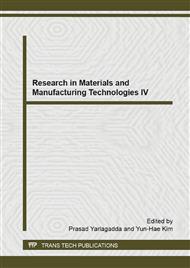[1]
G. Tiang, Y. Zhang, and R. Wang. Journal of Textile Research, 2014, 31(4): 15-19. (In Chinese).
Google Scholar
[2]
J. Yang, R. Wang, and Z. Ma. Proeeedings of the 3rdChina International Wool Textile Conference, 2002. (In Chinese).
Google Scholar
[3]
G. Sheng and L. Li. Wool Textile Journal, 2007, 12: 55-59. (In Chinese).
Google Scholar
[4]
Y. Lv, X. Ding, and J. Yang. Wool Textile Journal, 2011(3): 52-54. (In Chinese).
Google Scholar
[5]
R.S. Das, and Y.K. 2011, 57: 163-176.
Google Scholar
[6]
G. Zhu, X. Zhu, Q. Fan, etc. Spectrochimica Acta Part A, 2011, 78: 1187-1195.
Google Scholar
[7]
J. Li and L. Daia. Sensors and Actuators B, 2012, 173: 385-390.
Google Scholar
[8]
F. Fuest, R.S. Barlow, D. Geyer, etc. Proceedings of the Combustion Institute, 2011, 33: 815-822.
Google Scholar
[9]
B.N. Mavrin, L.N. Demyanets, and R.M. Zakalukin. Physics Letters A, 2010, 374: 4054-4056.
DOI: 10.1016/j.physleta.2010.06.045
Google Scholar
[10]
P.R. Carey, Y. Chen, Bo Gong, etc. Biochimica et Biophysica Acta, 2011, 1814 : 742-749.
Google Scholar
[11]
J.E. McGeehan, D. Bourgeois, A. Royant, etc. Biochimica et Biophysica Acta, 2011, 1814: 750-759.
DOI: 10.1016/j.bbapap.2010.07.021
Google Scholar
[12]
Q. Tu, MS, C. Chang. Nanomedicine: Nanotechnology, Biology, and Medicine, 2012, 8: 545-558.
Google Scholar
[13]
W.F. de Carvalho Rocha and R.J. Poppi. Analytica Chimica Acta, 2011, 705: 35-40.
Google Scholar
[14]
J. Wei and S. Ying. Wool Textile Journal,1989, 12: 492-493. (In Chinese).
Google Scholar
[15]
Z. Xu, T. Wang, and C. Li, etc. SCI/TECH Information Development and Economy, 2002, 12(5): 148-150. (In Chinese).
Google Scholar
[16]
S. Zhu, M. Jiang, W Wang, etc. Material review, 2010, 24(9): 50-53. (In Chinese).
Google Scholar
[17]
H. Chen, L. Zhang, Q. Wang, etc. Wool Textile Journal, 2014, 42(8): 1-4. (In Chinese).
Google Scholar
[18]
A. Wang and B. Yang. Journal of Zhong yuan institute of technology, 2003, 14(1): 73-75. (In Chinese).
Google Scholar
[19]
Y. Guo and M. Guo. Wool Textile Journal, 2006, 27(10): 96-98. (In Chinese).
Google Scholar
[20]
X. Zuo and D. Zhang. Ereals and Oil Processing, 2007, 70-72. (In Chinese).
Google Scholar


